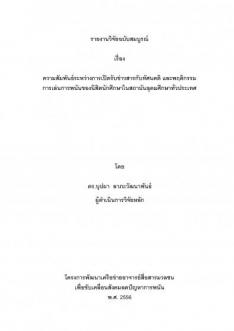

The Relationship between Media Exposure, Attitudes, and Gambling Behaviors of College Students in National Universities
by Buppa Lapawattanaphun
The objective of the study entitled “The Relationship Between Media Exposure, Attitudes and Gambling Behaviors of College Students in National Universities” is to examine Media Exposure, Attitudes and Gambling Behaviors of College Students in National Universities, as well as their correlations. The research employed a quantitative methodology, applying survey techniques and questionnaires for information gathering. Accessible population of the survey is defined as college students at nine universities belonging to the Mass Communication Lecturers Network for Gamble-Free Progressive Society in all major regions of the Kingdom. The nine universities are: Payap University, Chiang Rai Rajabhat University, Mahasarakham University, Burapha University, Walailak University, Kasetsart University Kamphaeng Saen Campus, Ramkhamhaeng University, Chandrakasem Rajabhat University, University of the Thai Chamber of Commerce. The sample size covers 900 respondents, using Taro Yamane's formula.
For sampling technique, the researcher has applied Purposive Sampling, by selecting college students from nine universities which are member of the Mass Communication Lecturers Network for Gamble-Free Progressive Society locating at all major regions throughout the Kingdom. Under such technique, the Quota Sampling has been made by establishing the proportion of potential respondents equally from nine universities, which are 100 students each. The researcher has applied Accidental Sampling to reach those potential respondents at each university, with an attempt to spread the sample groups as much as possible based on their demographic characteristics, covering 900 respondents totally.
In analyzing the information being collected, the principle researcher used descriptive statistics, comprising Frequency, Percentage, Mean, Standard Deviation. For testing hypotheses, One-way Analysis of Variance (ANOVA), Chi-Square, Pearson’s Product Moment Correlation Coefficient and an Independent-Samples T-Test statistics have been applied
The findings are as follows:
1. A majority of respondents obtained gambling information via personal media, mass media and new media. Friends were the personal medium used most to communicate information about gambling, while television was the most popular mass medium used by respondents to access such information. Websites and Facebook were the new media most commonly used by college students to find information about gambling.
2. A majority of respondents expressed positive attitudes toward gambling, reflecting the commonly held view among Thais that it is good to “try one's luck”. Despite this, a majority of respondents acknowledged that nobody becomes successful from gambling, and recognized that in general, gambling is not a good thing.
3. A majority of respondents reported having gambled. Most preferred playing cards, and reported that they started gambling while in primary school. The basic reasons they cited for starting to gamble were for fun, to pass the time, and curiosity.
4. The positive attitude towards gambling shown by college students is a result of their exposure to gambling information, especially via personal and mass media, such as television, which are highly persuasive, especially for male students at private universities with cumulative grade-point averages of between 1.01 and 2.00. These students typically receive between Bt20,001 and Bt30,000 a month from their parents.
5. Three major factors were found to have an obvious relationship with gambling behaviors among the respondents: 1) a positive attitude towards gambling; 2) exposure to information about gambling from friends, television and websites; and 3) demographic characteristics that encourage gambling activities, such as gender, type of university and average monthly income.

- by Buppa Lapawattanaphun
-
Gambling Industry: Thailand, England, America, Australia, and Malaysia
by Pasuk Pongpaijit et al.













